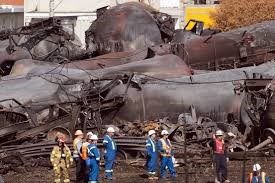Will Tough New Regulations Proposed for Transporting Crude Oil by Rail Benefit Shippers?
About 400,000 carloads of crude oil traveled by rail last year to the nation’s refineries, up from 9,500 in 2008, according to the Association of American Railroads. A series of recent accidents — including one in Quebec last July that killed 47 people and another in Alabama last November — has put pressure on regulators to look at the safety of crude oil shipments.
Train Derailment and Fire in Lac-Megantic, Quebec
On July 23rd of this year the Department of Transportation (DOT) responded. The DOT released the details of proposed rules to improve the safe transportation of large quantities of flammable materials by rail – particularly crude oil and ethanol. The proposed rules cover seven different areas associated with crude-by-rail transport, but the area that has gotten the most coverage are new rules requiring thicker steel for cars – either by purchasing new cars or retrofitting existing cars. The Wall Street Journal (WSJ) published an article pointing out that there are real doubts about the capacity of rail car makers, who already have a substantial backlog for tanker cars, and the rail car retrofitting industry, to make enough new cars to replace over 90,000 cars that won’t meet the new requirements.
For shippers that rely on rail, this is not necessarily a bad thing. In March, the WSJ published Surge in Rail Shipments of Oil Sidetracks Other Industries describing how the increased number of oil-by-rail shipments combined with bad weather to adversely impact agricultural products, coal producers and the utilities they supply, fertilizer manufacturers, and other industries.
“Many of the problems stem from pileups at BNSF Railway Co. in a critical northern stretch of the country where it is shipping crude oil from North Dakota’s booming Bakken Shale region. The railroad, one of the biggest in North America, was already taxed by the heavy demand for oil transport. But its difficulties multiplied when it ran out of locomotives and crew, as a bitter winter forced it to use smaller trains.
“That has caused a ripple effect across the country as shipments have been delayed. Deliveries of empty grain cars to farmers and grain elevators in the Midwest and Great Plains are running about two to three weeks late, the railroad says. The chief of a major sugar producer said he likes to load 50 railcars a day this time of year, but BNSF sometimes brings more than 50 and sometimes 30.”
Shale rail shipments primarily originate out of the Bakken – which is in North Dakota, Montana and Saskatchewan. The President of PLG Consulting, Travis Robinson, explained to me that as the pipeline infrastructure from the Bakken to the Gulf States built out, and because pipeline are a more economical way to transport crude, most of the rail shipments now move by unit trains to East and West coast markets. Thus, decreased shipments of crude oil could improve throughput on east-west rail movements. PLG Consulting is a boutique supply chain consulting firm.
On the other hand, the DOT is also proposing speed restrictions for crude rail shipments. They asked for comments on one of three options:
- A 40-mph maximum speed restriction in all areas;
- A 40-mph speed restriction in high threat urban areas;
- A 40-mph speed restriction in areas with a 100K+ population.
If tank cars meet the steel thickness and related tank car safety requirements, they could go 50-mph in all areas. The agency is also asking for better train braking and is looking to impose a 30-mph speed restriction oil tankers that do not comply with enhanced braking requirements.
But the railroads operate as a network, any restrictions on one type of shipment impacts shipments of all goods that use the network. The average train speed, a measure of the line-haul movement between terminals, at Tier 1 railroads ranges from mediocre to woeful. A Website called Railroad Performance Measures published the latest figures for Class 1 US railways. CN, for example, was the best with a reported average train speed of 27.8 mph in the latest reporting period (July 2014). CSX, the worst, only averaged 23.3 mph for their fleet.
This is an expedited regulatory process, there is only a little more than a month left to comment on the proposed rules. Shippers who use rail should consider weighing in. You can comment by going to this link.

No comments:
Post a Comment